标签:des style blog http color os io strong
A system switches between non-secure and secure modes by making processes, applications, and data for the non-secure mode unavailable to the secure mode and vice versa. The process thread run queue is modified to include a state flag for each process that indicates whether the process is a secure or non-secure process. A process scheduler traverses the queue and only allocates time to processes that have a state flag that matches the current mode. Running processes are marked to be idled and are flagged as unrunnable, depending on the security mode, when the process reaches an intercept point. The scheduler is switched to allow only threads that have a flag that corresponding to the active security mode to be run.
The present invention is directed to a computer system with an operating system secure scheduler and, more particularly to a single system that is capable of hosting secure and non-secure applications while maintaining the secure environment through a scheduler that determines the applications that can run, the devices that can be accessed, etc. based on the security mode of the system.
Today many individuals are required to perform secure work and use secure applications and perform non-secure work using non-secure applications, such as email. It is conventional wisdom that it is not possible to combine a secure system and a non-secure system in a single computing platform. The typical solution is to provide two separate systems, a secure system and a non-secure system. When an individual is performing non-secure work the non-secure system is used. To perform secure work, the user must log off of the non-secure system, physically move to the secure system and log into the secure system. Such dual systems are difficult to maintain, increase administrative overhead and result in reduced productivity for the individuals involved.
What is needed is a system that allows both types of applications to safely and securely co-exist on the same platform.
It is an aspect of the present invention to provide a single system that allows secure and non-secure operations on the same platform.
It is another aspect of the present invention to provide a system that does not allow and provides no opportunity to access secure processes, secure data, etc. when the system is running in a non-secure mode and visa versa.
It is also an aspect of the present invention to provide a system in which data structures prevent access to data and processes that do not correspond to the current mode.
It is an aspect of the present invention to provide data structures that prevent access to designated input/output (I/O) pathways and I/O devices that do not correspond to the current mode.
The above aspects can be attained by a system that switches between non-secure and secure modes by making processes and data for the non-active mode unavailable to the active mode. This prevents user from accessing data or processes non-corresponding to the current mode. This is accomplished in one embodiment by creating dual hash tables where one table is used for secure processes and one for non-secure processes. The path-name look-up function that traverses the path name tree to obtain a device or file pointer in another embodiment is also restricted to allow traversal to obtain a pointer to only secure devices and files when in the secure mode and to only non-secure devices and files in the non-secure mode. The process thread run queue in an embodiment is modified to include a state flag for each process that indicates whether the process is a secure or non-secure process. A process scheduler traverses the queue and only allocates time to processes that have a state flag that matches the current mode. A macro level switch between modes in the kernel is performed. Running processes are marked to be idled and are flagged as unrunnable, depending on the security mode, when the process reaches an intercept point. I/O paths of the running processes that are designated as accessible only by this security mode are also disabled. The switch operation, in an embodiment, pauses the system for a period of time to allow all running processes to reach an intercept point and be marked as unrunnable. After all the processes are idled, in an embodiment, the hash table pointer is changed, the look-up control is changed to allow traversal of the corresponding security mode branch of the tree, and the scheduler is switched to allow only threads that have a flag that corresponds to the security mode to run. I/O paths of the running processes that are designated as assessable only by this security mode or level are enabled. The master process, either secure or non-secure, depending on the mode is then awakened. Page swapping is also securely performed by swapping pages using devices with the same security level.
These together with other aspects and advantages which will be subsequently apparent, reside in the details of construction and operation as more fully hereinafter described and claimed, reference being had to the accompanying drawings forming a part hereof, wherein like numerals refer to like parts throughout.
A typical computer system?18, as depicted in?FIG. 1, includes various types of devices such as removable storage media?20, network an communication connections?22, permanent storage?24?and output device like a printer?26coupled to a central processor and memory?28?where a user accesses and using the components and their contents via an interface?30, such as a monitor and keyboard, as they perform their work.
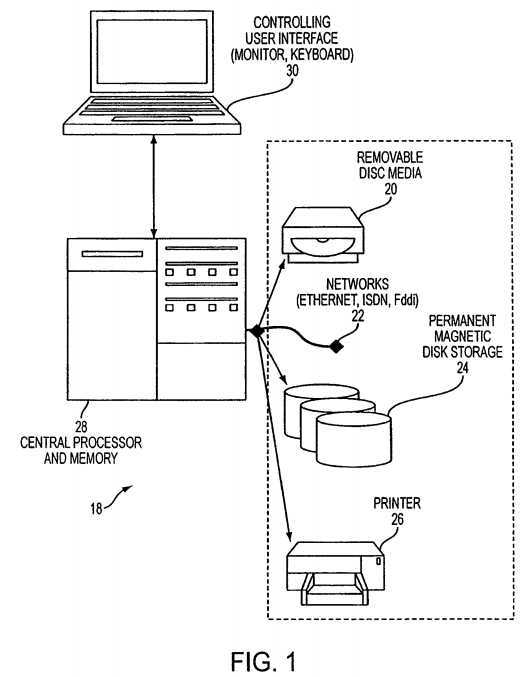
In a system?40?according to an embodiment of the present invention, as depicted in?FIG. 2, the components are physically partitioned into secure devices?42, such as permanent disk storage?44, and non-secure devices?46. Because the system40?includes both secure components and their secure contents as well as non-secure components, the system?40?is required to prevent a user from accessing secure components and information while in a non-secure mode, so that the transfer of secure information form the secure components to non-secure components, such as from permanent storage to a printer, is prevented. To accomplish this various structures and processes, as described in more detail herein are provided.
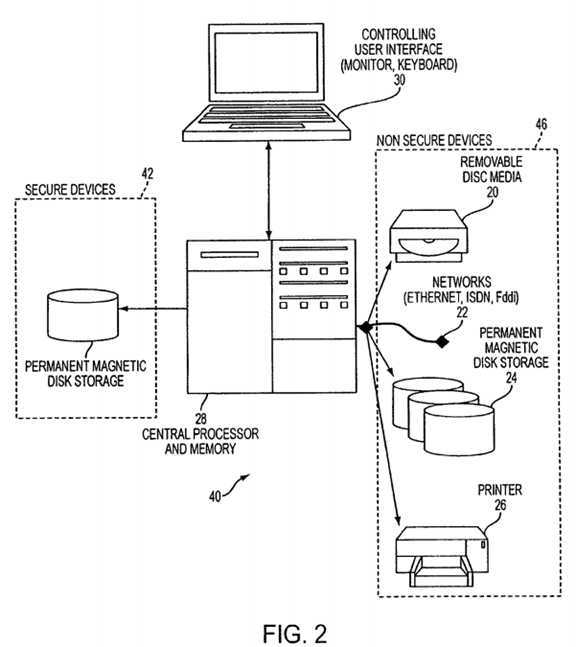
A typical operating system based computing environment?50, such as the UNIX environment to which the embodiments of the present invention can be applied, includes several levels as depicted in?FIG. 3. Similar environments can be found in other operating system environments and the present can be applied to those environments as well as others that are less similar. In the typical operating system environment, a user space or level?52?is provided in which user applications and programs are executed and in which the various libraries data, programs, etc. are assessed and used. A hardware space or level?54?is also provided where the hardware, such as depicted in?FIGS. 1 and 2, resides and operates. Between the user level?52?and the hardware level?54, exists a kernel space or level?56?in which the kernel of the system operates.
The kernel is a program that constitutes the central core of a computer operating system. It has complete control over everything that occurs in the system. The kernel is the first part of the operating system to load into the main memory (RAM) during booting, and it remains in the memory for the entire duration of the computer session. Because the code that makes up the kernel is needed continuously, it is usually loaded into a protected area of memory, which prevents it from being overwritten by other, less frequently used parts of the operating system or by application programs. Access to the kernel is limited to individuals with a proper level of authority, which is the "superuser". The kernel performs its tasks (e.g. executing processes and handling hardware and software interrupts) in kernel space, whereas everything a user normally does (e.g. writing text in a text editor or running graphical programs) is done in user space. This separation is provided in order to prevent user data and kernel data from interfering with each other and thereby diminishing performance or causing the system to become unstable (and possibly crashing). The kernel provides basic services for all other parts of the operating system, typically including memory management, process management, file management and I/O (input/output) management (i.e., accessing the peripheral devices). These services are requested by other parts of the operating system or by application programs through a specified set of program interfaces referred to as system calls.
Process management is the part of the kernel that ensures that each process gets its turn to run on the processor?28?and that the individual processes do not interfere with each other by writing to their areas of memory.
The contents of a kernel vary considerably according to the operating system, but they typically include a scheduler, which determines how the various processes share the kernel‘s processing time (including in what order), a supervisor, which grants use of the computer to each process when it is scheduled, an interrupt handler, which handles all requests from the various hardware devices (such as disk drives and the keyboard) that compete for the kernel‘s services and a memory manager, which allocates the system‘s address spaces among all users of the kernel‘s services.
The typical UNIX kernel level?56?(see?FIG. 3) includes a system call interface?58?that interacts with the user level?52?and hardware control?60?that interacts with the hardware level?54. The kernel level?56?also includes a file sub-system?62?that controls access to files within the system as well as access to the various hardware devices, such as a printer, through conventional buffers?64?and drivers?66. The UNIX kernel level?56?also includes a process control system?68?that controls the processes and includes an inter-process communication task?70, a scheduler?72?and a memory manager?74.
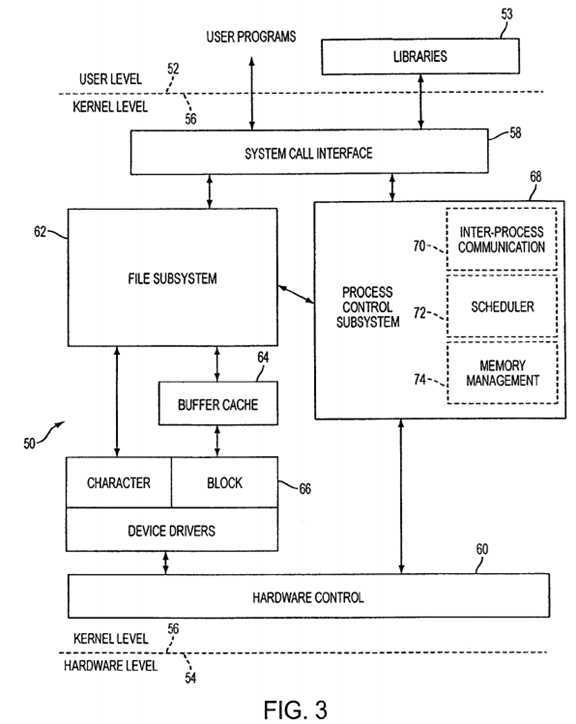
The system?90?of the present invention makes changes and additions to various ones of the kernel components discussed above as shown in?FIG. 4. An embodiment of the present invention provides, in the process control subsystem?68, a set of process tables?92,?94?including a secure process table?94?and an access mechanism (see?FIGS. 6 and 7) to access the tables based on the security mode. An embodiment includes a secure scheduler (see?FIG. 9) that executes secure processes or non-secure process responsive to the security mode. An embodiment also includes a secure path name switch?100?(see?FIG. 11) that provides paths to secure and non-secure files and devices based on the security mode. A switch process (see?FIG. 12) is also provided that allows the single system or platform to switch between non-secure mode and secure mode.
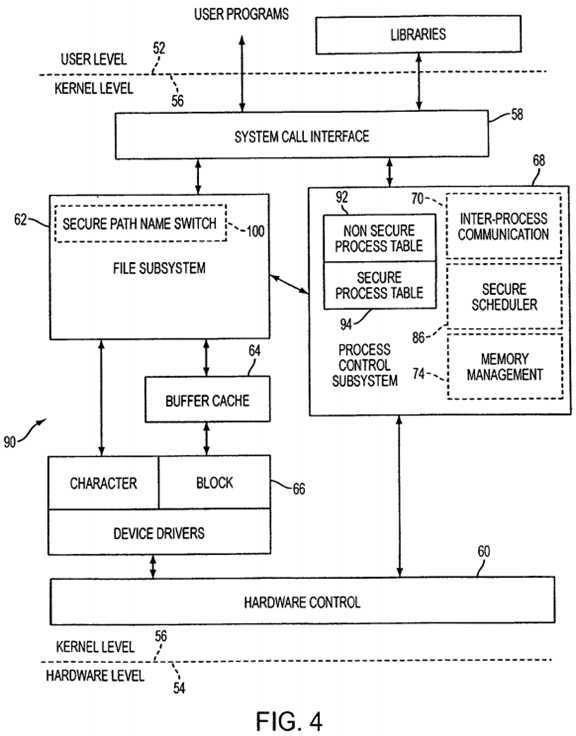
A conventional UNIX process table?110?(see?FIG. 5) in the kernel has a global pointer or hash table pointer?112?that points to the table?114?and each entry in the table essentially points to a system process (e.g. Process?1?. . . Process X) via a hash function (Index=HASH(pid)) that maps from index to location. A conventional operating system process accesses and uses the hash table to access the processes pointed-to by the table.
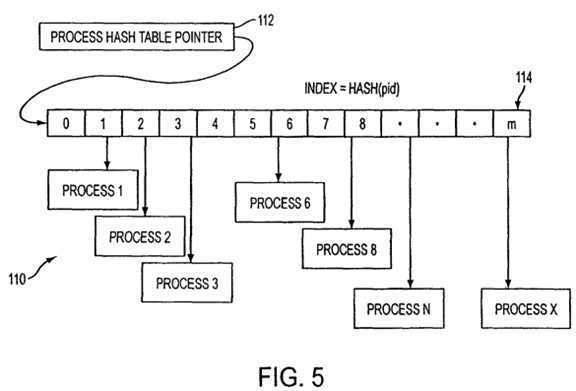
The process table data structure?130?of the present invention (see?FIG. 6) preferably includes two hash tables in the kernel, a non-secure hash table?132?that points to non-secure processes such as in?FIG. 5?and a secure hash table?134?that points to secure processes (e.g. Secure Process?1?. . . Secure Process X). Only secure processes are allowed to be entered into the secure table?134?and visa versa. Each of the tables includes corresponding table pointers?136?and?138?residing in the kernel. These pointers?136?and?138?are transferred to the process hash table pointer?140?also located in the kernel depending on the security mode. That is, during non-secure operations pointer?136?is transferred to pointer?140?and table132?is used and during secure operations pointer?138?is transferred to pointer?140?and table?134?is used.?FIG. 6?particularly depicts the pointer?140?pointing to the non-secure table?132?while?FIG. 7?depicts pointer?140?containing the contents of pointer?138?necessary to point to table?134. Once the pointer?140?is switched to either the secure contents (138) on non-secure contents (136) the operating system uses the conventional operations to use the hash table. By having two tables, when the system is in one or the other of the modes, the system does not even "know" that processes of the other mode exist and any user who somehow obtains access to the current table cannot start, run or locate a process corresponding to the other mode.
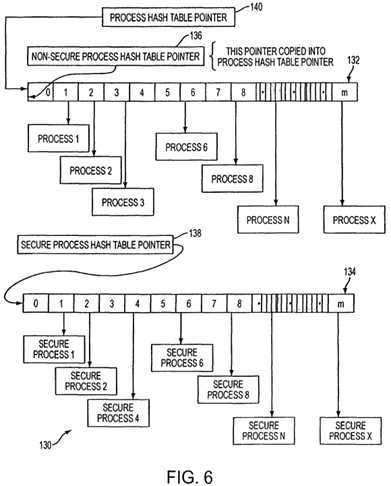
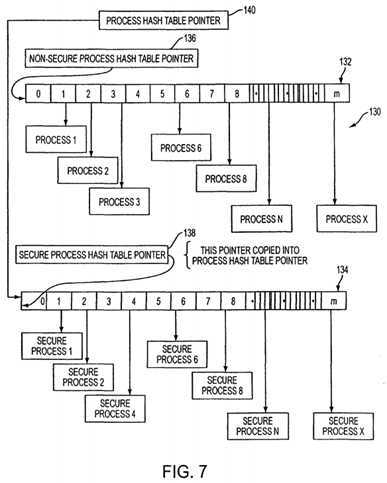
The conventional UNIX run queue organization scheduler?158?located in the kernel includes a process control structure?160(see?FIG. 8) linked to a run queue?162?where the run queue comprises a doubly linked list of all process thread structures164?including run condition flags. All of the process threads?164?depicted in this queue?162?are runnable (and non-secure) and the scheduler time sharing algorithms conventionally determine the order and amount of time each runnable process is given.

The process scheduler?165?queue organization of the present invention, as depicted in?FIG. 9, is similar to that of the conventional organization in that all of the processes (process structures with pointers to the processes), secure?166?and non-secure?164, are linked together in the kernel queue?162. However, in the non-secure mode only non-secure processes164?are allowed to run while in the secure mode only the secure processes?166?are allowed to run. This is accomplished by adding a process state flag (run condition flag?266), not viewable to the user, to each of the conventional process thread data structures (164,?166) of the queue (see the description associated with?FIG. 14?later herein). The process state flag indicates whether the process is secure or not. As the processes, secure or not secure, are loaded from corresponding devices and have appropriate secure process identifiers, the process state flag for each thread is set at the time that a process is loaded and the thread is placed on the queue. The conventional scheduler time sharing algorithms (are modified to) check the process state flag each time a next thread entry in the queue is accessed and only process threads that correspond to the security state are run. The modifications to the system flags and the scheduler discussed above are within the skill in the art.
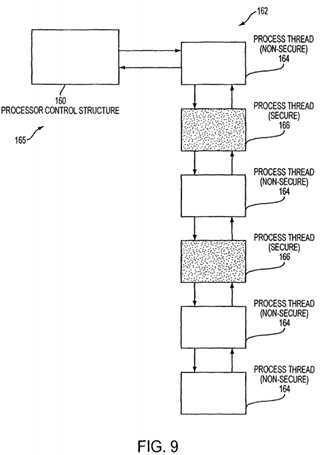
The conventional UNIX path name look-up system?180, as depicted in?FIG. 10, receives a request to open a file with a file name or device name and the path name look-up function or object?182?examines the root file system vnode?184?and the root file system directory and the file/device name is conventionally converted by the path name look-up traversal to a device driver pointer or a file name pointer within the system. The pointer is then conventionally used by the system to perform any needed device or file access.
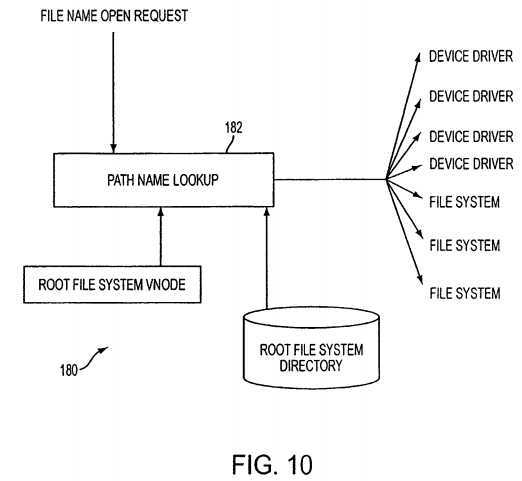
The path name look-up system?200?of the present invention, located in the kernel and as depicted in?FIG. 11, receives a request to open a file with a file name or device name and the path name look-up function or object?202, depending on whether the system is in a secure or non-secure mode, examines the non-secure (204) or secure (206) root file system vnode both located on a non-secure device and the non-secure (208) or secure (210) root file system directory located on secure devices. The directories and nodes do not have entries for files or devices that cannot exist in their corresponding mode. By separating the vnodes and directories, a request for a non-secure file name or device will not result in a path name to a secure file or device and the file/device name is converted by the path name look-up traversal (or routed) to a secure device driver pointer or a secure file name pointer within the system that correlates to the security mode of the system. That is, a secure pointer only is returned when in the secure mode and visa versa. The secure pointer is then conventionally used by the system to perform any needed device or file access. Files that are open when a path switch occurs remain open but are not usable because access to the pointer thereto is not possible. This security mode based multilevel directory switching can be provided by a person of skill in the art familiar with the IRIX6 operating system available from Silicon Graphics, Inc.

To prevent file systems designated as secure from being mounted and accessible to the non-secure mode, and vice versa, a physical device is identified internally to the kernel as the allowable root device of the secure mode. The designated secure root file system is not accessible due to a kernel data structure that has designated the security mode of the mounted file system. All subsequent file systems mounted within the hierarchy of the secure root file system cannot be accessed by the non-secure mode.
To further augment security, the secure file system may be physically protected and accessible only by providing some sort of authentication mechanism such as a biometric identification system.
In converting from a non-secure system mode to a secure system mode, operations associated with changing the pointers, etc. need to be performed. Theses operations are depicted in the process?230?of?FIG. 12. When a system switch is to occur?232, a system call is made by the non-secure master process ("init" in UNIX) to switch security modes at which time the kernel (not accessible by a user or user application) is entered and the switch process residing in the kernel is executed. First, the kernel validates?234?that this initiated switch process is authorized to initiate a switch. This involves the kernel performing authentication steps, such as determining whether the user has the authority to initiate a switch by checking a password, performing a biometric identification, etc. Once authentication is complete, the system enters an administrative state. The system sets a bit in the kernel system flags indicating that the system in a secure mode as discussed later herein. In this administrative state, the kernel switches the process scheduler?165, which decides what gets control of the CPU, to conventionally idle?236?all processes except the switch process (i.e. make them all unrunnable) and I/O paths are disabled. Then, the system pauses or waits a predetermined period of time to allow all processes time to reach a security checkpoint at which time they can be idled (see?FIG. 16). 100 milliseconds is the preferred period of time for internal processes as this is typically sufficient in most systems for all processes to reach a check point where all data, pointers, states, etc. are not changing and can be preserved. For example, a non-secure file access that is in progress needs to be allowed to reach a stopping point where the hardware is essentially not active for the access. However, a pause time suitable for a particular system should be set. For example, if the system includes a telephone modem, a pause of 3 seconds would typically and preferably be appropriate. Once all processes have been idled, the operation changes?240?the process table pointer to point to the secure process hash table. That is, the pointer?138?is loaded in to pointer?140?as depicted in?FIG. 7. Next, the system changes?242?the file name lookup control (see?FIG. 200) to redirect all file name accesses to the secure root file system enabling I/O paths for secure data and processes. Now, the scheduler?165?is switched?246?to allow all secure processes to be runnable. Finally, this running switch process is set?248?to go to sleep and now that the system is allowing all secure processes to run, the secure init master process is awakened (the administrative mode is exited) and the secure processes are conventionally started or un-idled. (init is one of the only programs the kernel ever executes explicitly; the responsibility is on init to bring the secure UNIX system up, init always has the process ID and is typically called process?1.)
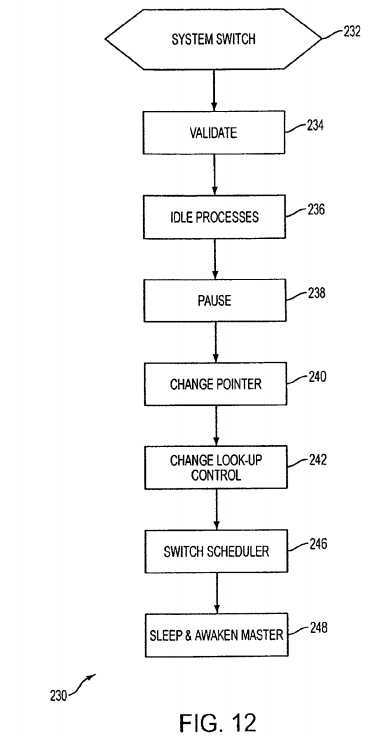
To switch from secure mode to non-secure mode, the kernel is entered and operations?234-238?are performed. Operation240?changes the process table pointer to point to the non-secure process hash table while operation?242?changes the file name lookup control to redirect all file name accesses to the non-secure root file system. Operation?246?switches the scheduler to allow all non-secure processes to be runnable. And the system causes?248?this running switch process to sleep and as the system is now allowing all non-secure processes to run, the non-secure init master process is awakened.
Conventionally, during initial start-up (in non-secure mode) a cold start occurs in which the kernel is loaded and starts running. The kernel performs conventional housekeeping, such as data structure initialization, and then mounts the non-secure root file system. Once the root file system is mounted, the kernel looks for, loads and runs non-secure init (the non-secure master process). The master process reads a start-up file from a non-secure disk that controls a sequence of programs loads, etc. as defined in the start-up file that attach devices, windows generation, etc., the administrative mode is exited and non-secure processing commences. During processing, when an application is to be run, the master process conventionally forks a login process that allows log-in. The log-in process is then forked and then the new log-in process replaces itself with the application to be run. That is, all processes are children of the master process and inherit the security mode of the master. During processing the kernel knows, via the mode status bit or flag, whether it is in the secure mode. The system is also modified to include an initial secure load status flag that indicates whether the system has entered the secure mode for the first time. In the first switch to secure mode, that is, the first time that the system is switched to secure mode, the process hash table is empty and this needs to be addressed. To do this, the system recognizes that this is the first switch to secure mode by checking the initial secure load status flag. When it is the first secure mode switch, the kernel recognizes that this is a cold start for the secure mode and mounts the secure root file system. Once the secure root file system is mounted, the kernel looks for, loads and runs secure init (the secure master process). The secure master process reads a secure start-up file from disk that controls a sequence of programs loads, etc. as defined in the secure start-up file that allows secure log-in, windows generation, etc., sets the initial secure load status flag to show that the secure master process has been started, the administrative mode is exited and secure processing commences by forking the secure master and essentially replacing it with secure application processes. The forked/replaced child process inherits the unchangeable security level of the parent, in this case the secure master and it‘s secure status. In this way, all child processes are locked into their parent security status. By providing the initial secure load status flag, the system allows the secure mode to be started for the first time at any time. That is, the system could be started and run for several days before the secure mode is entered. The initial start of the system need not start both the non-secure and secure systems and the secure system need not be started until it is needed. A person of skill in the art can add the initial secure load status flag and make the changes to the kernel necessary to check this bit and perform a cold start for the secure side of the system.
The security mode flag that indicates whether the system is in the secure mode or the non-secure mode can be a multiple bit entity carrying a value, such as an integer value, that will allow the system to have multiple security levels and multiple secure systems running on the same platform. When the system is intended to run several levels of security then a multiple bit flag is preferred. When only a single secure system is resident on the system, the security level integer takes on values of 0 (non-secure) and 1 (secure).
In the scheduler?86, there is an integer value?262, the switch count, (see?FIG. 13) which is incremented upon notification of a switch to a new security mode. There is also an integer value?264?that designates the desired security mode. There is an additional flag bit?266?(security runnable flag) defined for each running process that designates whether or not the process can be allowed to run by the scheduler. Each process holds a copy?268?of the switch count at the time of last examination. Each process (and process space) keeps a security mode designator?270,272?to identify the security mode it is runnable on.
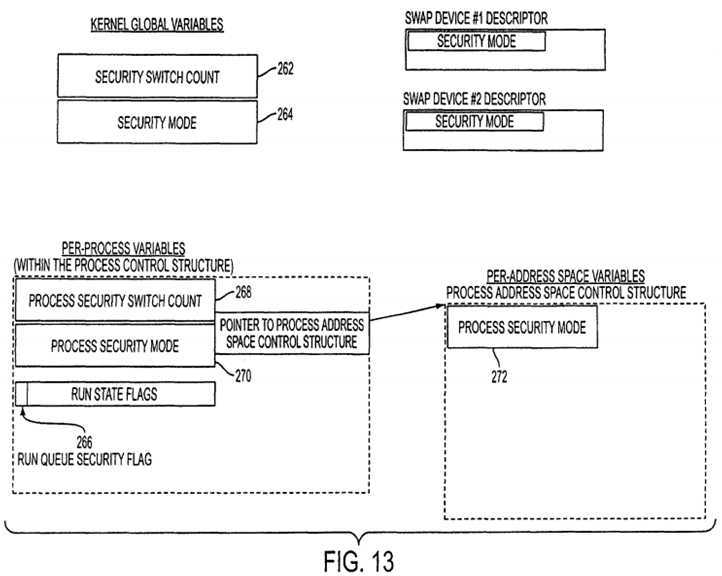
At the start of normal, non-secure processing after the initial boot up, the switch count is zero and each process has its switch count, security mode, and security runnable flag bit set to zero. The system operates normally.
At the time of a security mode change, the administrative process, which controls the switching, will increment the security switch count?262?by 1. The security mode?264?is set to the new security mode. All running processes are sequentially examined, and those with a security mode?270, not equal to the new security mode?264?will have the security runnable flag266?set to a 1.
To do this, the process scheduler?86?examines?282?(see?FIG. 14) each candidate process on the run queue to determine the next process to run. The security runnable flag?266?is examined?284?and any process with the flag not set in conventionally examined?286?with the standard scheduler criteria and run or not run. Any process on the run queue with a security runnable flag set is further examined to determine if the process is to remain un-runnable, or the process is designated as runnable in the new security mode and therefore must be made runnable. This further examination is optimized by comparing?288?the secure switch count?262?of the system with the secure switch count?268?of the process. If the counts are equal, there has been no change since last examination and the scheduler moves on to examine?282?the next process. If the counts are unequal, the process switch count?268?is updated?290. Then the security mode of the system is compared?292?to the security mode of the process. If the values are equal then the security runnable flag is cleared?294and this process is now runnable if the other run criteria?286?are met. In this operation the security switch count of the process has been updated (290) to match the system wide secure switch count, so that no further examination by the scheduler is needed until the next switch operation occurs.
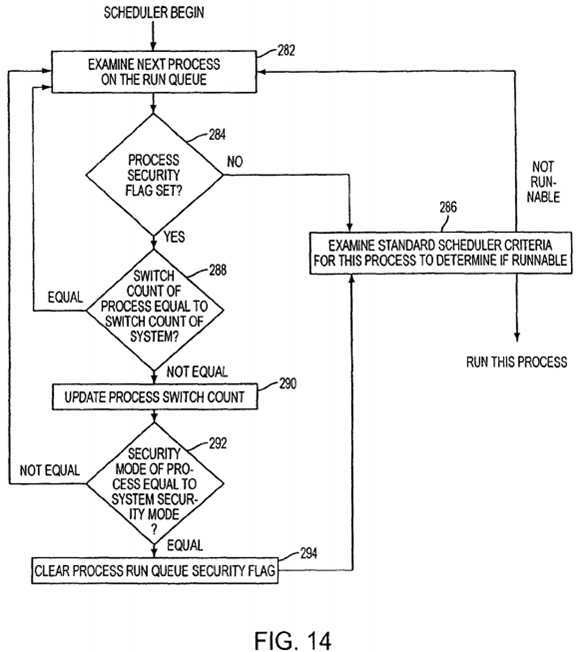
The above discussion deals with processes that are on the run queue. Some processes that can run are not on the run queue because their operation has been suspended, such as a process that is waiting for data to be loaded into a queue. These processes that can return to the run queue are captured or trapped at intercept points (see?FIG. 16). When such a trap or intercept occurs, at the start of the intercept, the system compares?312?the secure switch count of the system with the secure switch count of the process. If the counts?262?and?268?are equal, no intercept is needed and normal processing continues?314. If the counts?262?and?268?are unequal, the process switch count?268?is updated?316. Then the security mode of the system is compared?318?to the security mode of the process. If the values are not equal then the security runnable flag is set?320?and the scheduler is forced to reexamine this process (where the scheduler will determine not run this process).
The present invention also handles page swapping in a secure manner. Page swapping occurs when virtual memory systems over commit the available physical memory and cause least recently used pages to be written out to disk in a swap area. In the present invention, the pages associated with secure applications are only swapped to a designated secure disk by the kernel, and likewise for non-secure applications to non-secure disks only. This is accomplished by the system recognizing the current mode (from the mode bit—see?FIG. 13-264), having a list of secure and non-secure devices. When in a secure mode secure pages are swapped to secure devices and not secure pages are moved out to non-secure devices. That is, the swapper searches all process address spaces to swap out the least recently used pages. When a page is deemed to be swapped out, it is swapped to the swap device that has the same security mode (see?FIG. 13) as the process address space security mode?272.
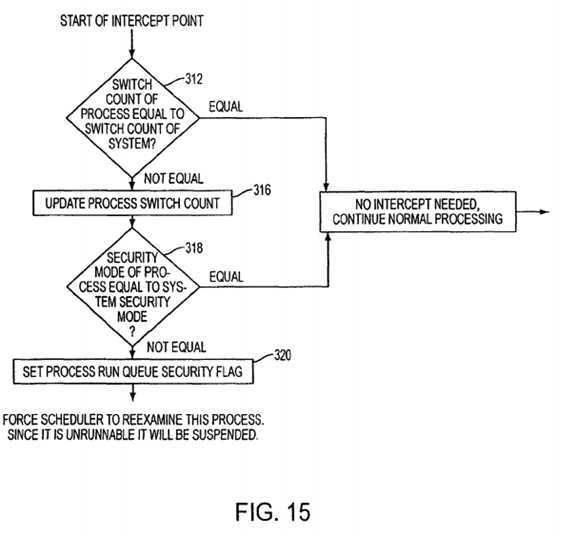
As noted above, the switch from the non-secure to secure mode and back requires that processes be idled and made unrunnable.?FIG. 16?depicts the typical operating states of a UNIX process?360?and the security check or intercept points362?where processes can be switched to unrunnable. When the kernel state?2?transfers to an interrupt state, no security check points are available as interrupts, such as hardware buffer loading interrupt operation, must be allowed to finish. User processes?1?initiated by the scheduler have several intercept points?362?when a system call to the kernel occurs or when an interrupt is processed or when a return from a system call or interrupt occurs. A trap or intercept point?362?is also available between the sleep state?4?(where, for example, the process is awaiting an I/O completion and is not on the run queue) and the ready to run state?3?when a process is being awakened and is to be placed back on the run queue. Depending on the particulars states of other operating system kernels that may be other intercept/trap points.
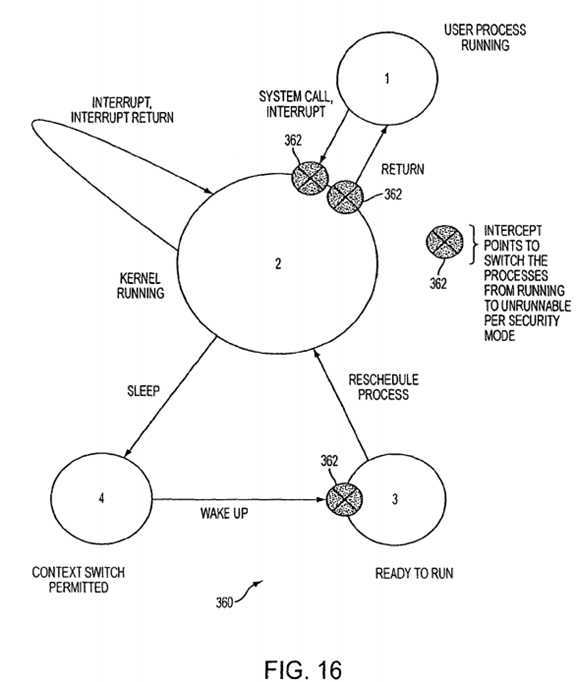
With the data structures and processes discussed above, the present invention allows secure processes to be run on the same platform?380?as non-secure processes as depicted in?FIG. 17. A non-secure environment?382?is executable within the system kernel?286?as well as a secure environment?384. Non-secure devices?388?and secure devices?390?are both accessible by the shared devices?392.

The system also includes permanent or removable storage, such as magnetic and optical discs, RAM, ROM, etc. on which the process and data structures of the present invention can be stored and distributed. The processes can also be distributed via, for example, downloading over a network such as the Internet.
A system according to the present invention includes the storage, RAM, ROM, disc, etc. for storing the processes and data structures of the present invention discussed herein.
As noted above, during a switch the present invention includes a pause that allows the executing processes to reach an intercept point. It is possible, as an alternative, that rather than have a pause, the state of all of the processes can be tracked and any I/O can also be tracked, and when all processes have been idled and all I/O processes completed or terminated, the system can continue with the switch.
The present invention has been described with respect to providing a single path name look-up function. As an alternative, it is possible to have duplicated the function (like the dual hash tables), so that a function is available for non-secure look-ups and a function is available for secure look-ups.
The invention has been described with a single scheduler queue. As an alternative the scheduler queue could be duplicated.
SRC=https://www.google.com.hk/patents/US8433902
Computer system with dual operating modes,布布扣,bubuko.com
Computer system with dual operating modes
标签:des style blog http color os io strong
原文地址:http://www.cnblogs.com/coryxie/p/3896767.html